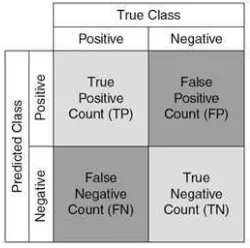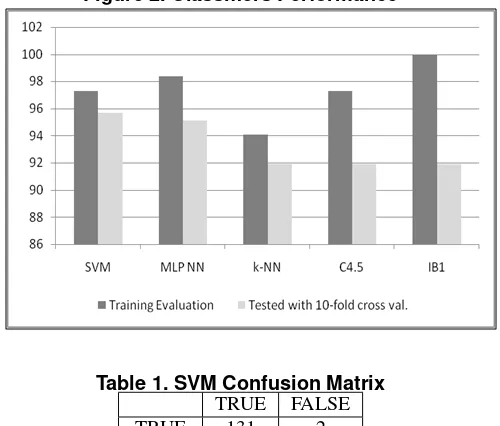Detection of Type 2 Diabetes Mellitus with Data Mining Approach Using
Support Vector Machine
Bayu Adhi Tama,
1Afriyan Firdaus,
2Rodiyatul FS
3 1,2,3
Faculty of Computer Science, University of Sriwijaya
Inderalaya, Ogan-Ilir, Indonesia
1
bayu
@
unsri.ac.id,
2afriyan firdaus
@
yahoo.com,
3ebecedeh
@
yahoo.com
Abstract
Diabetes is a chronic disease and a major problem of morbidity and mortality in developing countries. The In-ternational Diabetes Federation (IDF) estimates that285
million people around the world have diabetes. This total is expected to rise to438million within20years. Type 2 diabetes (TTD) is the most common type of diabetes and ac-counts for 90-95 percent of all diabetes. Detection of TTD from various factors or symptoms became an issue which was not free from false presumptions accompanied by un-predictable effects. According to this context, data mining could be used as an alternative way, help us in knowledge discovery from data. This paper utilize support vector ma-chine (SVM) in the data mining process to acquire infor-mation from historical data of patient medical records. It offers a decision-making support through early detection of TTD for physicians and others.
Keywords: data mining, medical record, support vector machine, type 2 diabetes mellitus.
1. Introduction
Diabetes is an illness which occurs as a result of prob-lems with the production and supply of insulin in the body [3]. People with diabetes have high level of glucose or ”high blood sugar” calledhyperglycaemia. This leads to serious long-term complications such as eye disease, kidney dis-ease, nerve disdis-ease, disease of the circulatory system, and amputation that is not the result of an accident.
Diabetes also imposes a large economic impact on the national healthcare system. Healthcare expenditures on di-abetes will account for 11.6% of the total healthcare expen-diture in the world in 2010. About 95% of the countries covered in this report will spend 5% or more, and about 80% of the countries will spend between 5% and 13% of their total healthcare dollars on diabetes [7].
TTD is the most common type of diabetes and accounts for 90-95% of all diabetes patients and most common in people older than 45 who are overwieght. However, as a consequence of increased obesity among the young, it is becoming more common in children and young adults [3].
Diabates has no obvious clinical symptoms and not been easy to know, so that many diabetes patient unable to ob-tain the right diagnosis and the treatment. Therefore, it is important to take the early detection, prevent and treat dia-betes disease, especially for TTD.
Recent studies by the National Institute of Diabetes and Digestive and Kidney Diseases (DCCT) in UK have shown that effective control of blood sugar level is beneficial in preventing and delaying the progression of complications of diabetes [5]. Data mining techniques could be used as an alternative way in discovering knowledge from the pa-tient medical records and SVMs has shown remarkable suc-cess in the area of employing Computer Aided Diagnos-tic systems (CAD) as a ”second opinion” to improve diag-nostic decisions [4]. SVMs also have demonstrated highly competitive performance in numerous real-world applica-tion such medical diagnosis, SVMs as one of the most pop-ular, state-of-the-art data mining tools for knowledge dis-covery and data mining [9].
Several studies have been conducted regarding TTD de-tection. Rule extraction from SVMs has been conducted by Barakat [1], an experts system based on pricipal com-ponent analysis (PCA) and adaptive neuro-fuzzy inference systems, Polat and Gunes reported in [8], In [10] Yu et al combined Quantum Particle Swarm Optimization (QPSO) and Weighted Least Square (WLS)-SVM to diagnose type 2 diabates, whereas Huang et al used complementary of three classification techniques such as Naive Bayes, C4.5, and IB1 can be found in [2].
This paper is organized as follow: a brief explained of support vector machine and medical data used is provided in section 2. The detailed information is given for each sub-sections. Section 3 gives result and discusion, and finally, in section 4 we conclude the paper with summarization of
the result by emphasizing this study and also mentioning for future research.
2. Material and Method
2.1. Datasets Used
This datasets was taken from one of public hospital in Palembang, South Sumatera. All patients of this database are men and women at least 10 years old. The variable takes the value ”TRUE” and ”FALSE”, where ”TRUE” means a positive test for TTD and ”FALSE” means a negative test for TTD.
There are 185 cases, where 71,9% (133) cases in class ”TRUE” and 17,8% (53) cases in class ”FALSE”. There are ten clinical attributes:(1) Gender (male, female), (2) Body mass (thin, medium, overweight), (3) Blood pressure (<140/90,≥140/90), (4) Hyperlipidemia (true, false), (5) Fasting blood sugar (FBS) (<126 mg/dl,≥126 mg/dl) , (6) Instant blood sugar (<200 mg/dl,≥200 mg/dl), (7) Case history (true, false), (8) Diabetes Gest history (true, false), (8) Habitual Smoker (true, false), (9) Plasmainsulin (high, low), and (10) Age (children, adult, old).
2.2. Support Vector Machine
Support vector machine (SVMs) are supervised learning methods that generate input-output mapping functions from a set of labeled training datasets. The mapping function can be either a classifiaction function or a regression function [6]. According to Vapnik [9], SVMs has strategy to find the best hyperplane on input space called the structural mini-mization principle from statistical learning theory.
Given the training datasets of the form
{(x1, c1),(x2, c2), ...,(xn, cn)} where ci is either 1
(”yes”) or 0 (”no”), an SVM finds the optimal separating hyperplane with the largest margin. Equation (1) and (2) represents the separating hyperplanes in the case of separable datasets.
w.xi+b≥+1, forci= +1(1) w.xi+b≤-1, forci= -1(2)
The problem is to minimize|w|subject to constraint (1). This is called constrainted quadratic programming (QP) op-timization problem represented by:
minimize(1/2)kw2k
subject toci(w.xi-b)≥1(3)
The optimal value for the SVM can be shown to be:
max n X
i=1
αi− X
i,j
αiαjcicjxTixj(4)
Figure 1. Simple Confusion Matrix
where the α constitutes a dual representation for the weight vector in terms of the training set:
w=X
i
αicixi(5)
2.3. Performance Evaluation
Error can be measured in different ways. Error refers to difference between the output of the systems and the desired response. In classification problems, performance measure-ment can be represented with confusion matrix as Figure 1 [6].
Estimating the model can be used to estimate its fu-ture prediction accuracy. The simple method is holdout, which partitions the data into two mutually exclusive sub-sets called training set and test set (aka holdout set) [6].
In order to minimize the bias associated with training and holdout data, one can use methodology calledk-fold cross validation. Ink-fold cross validation, the complete datasets is split intoksubsets with equal size and then the model is trained and tested ktimes. The cross validation accuracy (CVA) is defined as [6]:
CV A= 1
k k X
i=1
Ai(6)
3. Result and Discussion
The experiment compares performance of SVM with 4 other classical methods such ask-Nearest Neighbour clas-sifier, neural network, C4.5 Decision Tree, and instance based learner (IB1). This SVM uses polynomial as ker-nel method withC = 250007andE = 1. The classifier is validated usingk-fold cross validation withk= 10.
Figure 2. Classifiers Performance
Table 1. SVM Confusion Matrix TRUE FALSE
TRUE 131 2
FALSE 6 46
The following graph (Figure 2) shows performance of each classifiers in percent. Here, SVM performs the best among other methods with accuracy 97,3%. Detail accu-racy of SVM can be shown as Table 1.k-Nearest Neighbour withk = 10has the same worst performance with C4.5 Decision Tree which has accuracy 91,89%. Surprisingly, IB1has also the same worst performance with accuracy 91, 89%. This result opposes to Huang et al [2] which stated thatIB1 performed the best among the classical methods (e.g. C4.5 Decision Tree).
Confusion matrix shows that SVM performs most cor-rect classification with class label TRUE is corcor-rectly clas-sified as positive test for TTD (131 cases) and only 2 cases are misclassified. However, class label FALSE is also cor-rectly classified as negative test for TTD (46 cases) and only 6 cases are misclassified. It can be concluded that SVM cor-rectly classifies 177 cases of 185 cases.
Rules are extracted using decision tree (C4.5) after trained with SVM as follow:
IF plasmainsulin = high AND fasting blood sugar≥126 THEN Class = TRUE (116 cases)
IF plasmainsulin = high AND fasting blood sugar<126 AND family history = true AND instant blood sugar≥200 THEN Class = TRUE
IF plasmainsulin = low AND
fasting blood sugar<126 THEN Class = FALSE
4. Conclusion
This paper collects and analyzes medical patient record of type 2 diabetes mellitus (TTD) with knowledge discovery techniques to extract the information from TTD patient in one of public hospital in Palembang, South Sumatera.
The experiment has successfully performed with data mining technique. Support vector machine (SVM) as part of data mining technique achieves better performance than other classical methods such as neural network, C4.5,k -nearest neighbour, andIB1. Rules are extracted using deci-sion tree can be used by physician to diagnose TTD disease. Finally, this experiment is being optimized and later it will focus on increasing the datasets in order to maximized result.
References
[1] Barakat and et al. Intelligible support vector machines for diagnosis of diabetes mellitus. InIEEE Transactions on In-formation Technology in BioMedicine, 2009.
[2] Huang and et al. Feature selection and classification model construction on type 2 diabetic patients´s data. Journal of Artificial Intelligence in Medicine, pages 251–262, 2008. [3] InternationalDiabetesFederation(IDF). What is diabetes?,
2010. Available from http://www.idf.org.
[4] N. Lavrac, E. Keravnou, and B. Zupan. Intelligent data anal-ysis in medicine.In Encyclopedia of Computer Science and Technology, 42, 2000.
[5] NationalDiabetesInformationClearinghouse(NDIC). The diabetes control and complications trial and follow-up study, 2010. Available from http://diabetes.niddk.nih.gov/dm/pubs/control.
[6] D. L. Olson and D. Dulen. Advanced Data Mining Tech-niques. Springer Verlag, Berlin, 2008.
[7] Z. Ping and et al. Economic impact of diabetes. In-ternational Diabetes Federation, 2010. Available from http://www.diabetesatlas.org.
[8] K. Polat and S. Gunes. An expert system approach based on principal component analysis and adaptive neuro-fuzzy inference system to diagnosis of diabetes disease. InExpert System with Applications, pages 702–710. Elseivier, 2007. [9] V. N. Vapnik.Statistical Learning Theory. Wiley, 1998. [10] Yue and et al. An intelligent diagnosis to type 2 diabetes
based on qpso algorithm and wls-svm. InInternational Sym-posium on Intelligent Information Technology Application Workshops. IEEE Computer Society, 2008.

